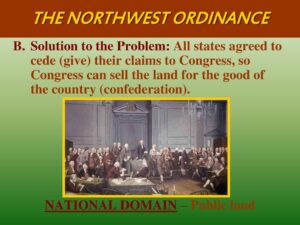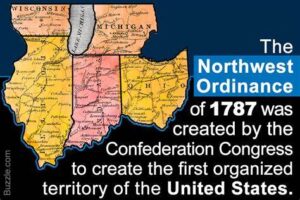 It never really occurred to me that the formation of new states in the United States would be the huge undertaking that it actually became. I just assumed that as the settlers moved into an area, they eventually got populated enough to decide to be a state. Of course, I realized that they would have to “petition” the national government for acceptance, but that wasn’t all there was to it at all. The United States had acquired the Northwest Territory (the Midwest today) in a number of steps. First, when it was relinquished by the British. Second, extinguishment of states’ claims west of the Appalachians. And finally, usurpation or purchase of lands from the Native Americans. Originally, the Hudson’s Bay Company acquired the area under a charter from Charles II in 1670. Then, in 1869, the Canadian government bought the land from the company. The boundaries we now have were set in 1912. In 1870, Canada acquired an area known as Rupert’s Land and the North-Western Territory from the Hudson’s Bay Company for £300,000 (Canadian $1.5 million) and a large land grant.
It never really occurred to me that the formation of new states in the United States would be the huge undertaking that it actually became. I just assumed that as the settlers moved into an area, they eventually got populated enough to decide to be a state. Of course, I realized that they would have to “petition” the national government for acceptance, but that wasn’t all there was to it at all. The United States had acquired the Northwest Territory (the Midwest today) in a number of steps. First, when it was relinquished by the British. Second, extinguishment of states’ claims west of the Appalachians. And finally, usurpation or purchase of lands from the Native Americans. Originally, the Hudson’s Bay Company acquired the area under a charter from Charles II in 1670. Then, in 1869, the Canadian government bought the land from the company. The boundaries we now have were set in 1912. In 1870, Canada acquired an area known as Rupert’s Land and the North-Western Territory from the Hudson’s Bay Company for £300,000 (Canadian $1.5 million) and a large land grant.
That left the United States with a kind of dilemma, since they wanted to make sure these new states were run in the way they had originally designed. So, on July 13, 1787, Congress enacts the Northwest Ordinance, to structure the settlement of the Northwest Territory. Since the formation of new states was a new venture for  the young nation, they had to create a policy for the addition of these new states. Vitally important was the need to make sure their new nation thrived and survived. The members of Congress knew that if their new confederation were to survive intact, it had to resolve issue of the states’ competing claims to western territory.
the young nation, they had to create a policy for the addition of these new states. Vitally important was the need to make sure their new nation thrived and survived. The members of Congress knew that if their new confederation were to survive intact, it had to resolve issue of the states’ competing claims to western territory.
That said, in 1781, the state of Virginia began the process by ceding its extensive land claims to Congress. That bold move made other states more comfortable in doing the same. Thomas Jefferson first proposed a method of incorporating these western territories into the United States in 1784. His plan was to basically turn the territories into colonies of the existing states. Since each state was to have their own constitution, the ten new northwestern territories would select the constitution of an existing state that closely aligned with their own values. Once that process was complete, the new territory (colony) had to wait until its population reached 20,000 to join the confederation as a full member. That process made Congress nervous, because they feared that the new states…10 in the Northwest as well as Kentucky, Tennessee and Vermont…would quickly gain enough power to outvote the old ones, so Congress never passed Thomas Jefferson’s proposal.
It would be three more years before the Northwest Ordinance which proposed that “three to five new states be created from the Northwest Territory. Instead of adopting the legal constructs of an existing state, each territory would have an appointed governor and council. When the population reached 5,000, the residents could elect their own assembly, although the governor would retain absolute veto power. When 60,000 settlers  resided in a territory, they could draft a constitution and petition for full statehood. The ordinance provided for civil liberties and public education within the new territories, but did not allow slavery.”
resided in a territory, they could draft a constitution and petition for full statehood. The ordinance provided for civil liberties and public education within the new territories, but did not allow slavery.”
The last part angered the pro-slavery Southerners, but they were willing to go along with this because they hoped that the new states would be populated by white settlers from the South. They believed that although these Southerners would have no enslaved workers of their own, they would not join the growing abolition movement of the North. Of course, we all know how that played out.


Leave a Reply